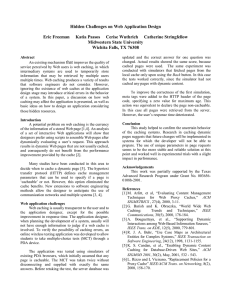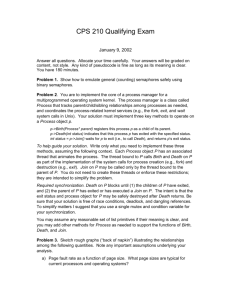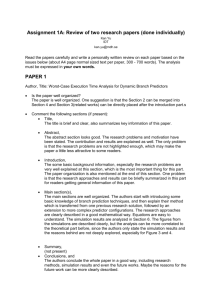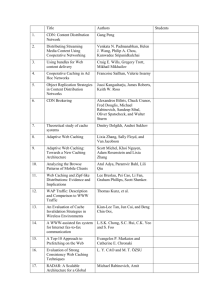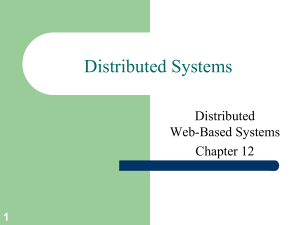www.ijecs.in International Journal Of Engineering And Computer Science ISSN:2319-7242
advertisement
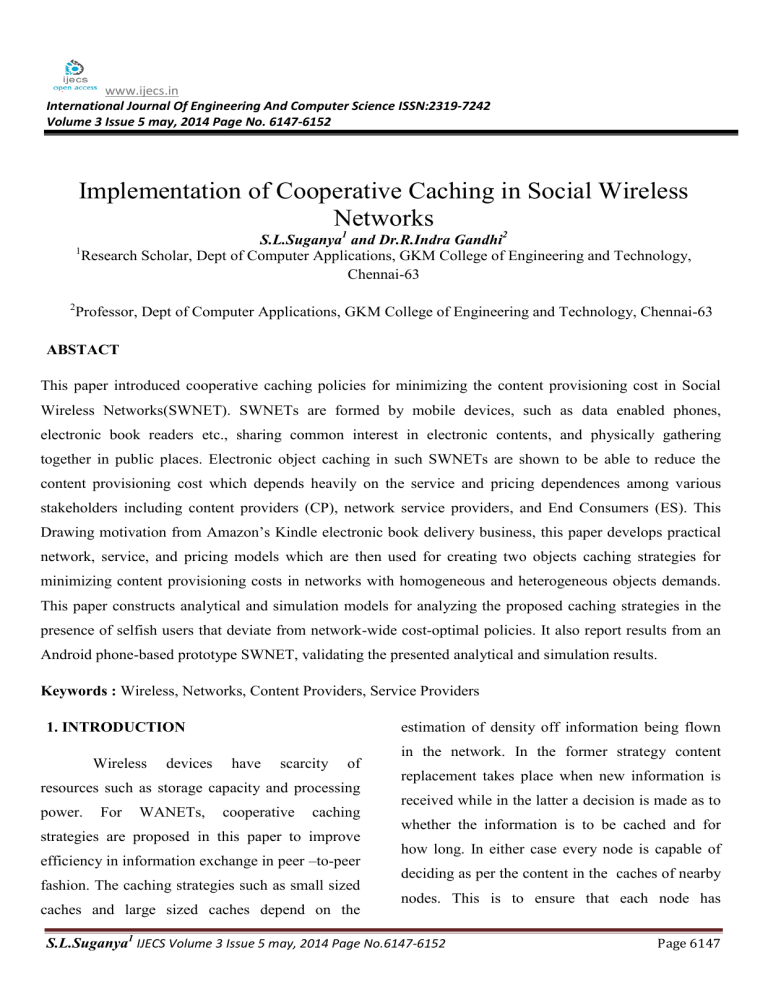
www.ijecs.in International Journal Of Engineering And Computer Science ISSN:2319-7242 Volume 3 Issue 5 may, 2014 Page No. 6147-6152 Implementation of Cooperative Caching in Social Wireless Networks 1 2 S.L.Suganya1 and Dr.R.Indra Gandhi2 Research Scholar, Dept of Computer Applications, GKM College of Engineering and Technology, Chennai-63 Professor, Dept of Computer Applications, GKM College of Engineering and Technology, Chennai-63 ABSTACT This paper introduced cooperative caching policies for minimizing the content provisioning cost in Social Wireless Networks(SWNET). SWNETs are formed by mobile devices, such as data enabled phones, electronic book readers etc., sharing common interest in electronic contents, and physically gathering together in public places. Electronic object caching in such SWNETs are shown to be able to reduce the content provisioning cost which depends heavily on the service and pricing dependences among various stakeholders including content providers (CP), network service providers, and End Consumers (ES). This Drawing motivation from Amazon’s Kindle electronic book delivery business, this paper develops practical network, service, and pricing models which are then used for creating two objects caching strategies for minimizing content provisioning costs in networks with homogeneous and heterogeneous objects demands. This paper constructs analytical and simulation models for analyzing the proposed caching strategies in the presence of selfish users that deviate from network-wide cost-optimal policies. It also report results from an Android phone-based prototype SWNET, validating the presented analytical and simulation results. Keywords : Wireless, Networks, Content Providers, Service Providers estimation of density off information being flown 1. INTRODUCTION Wireless devices have scarcity of resources such as storage capacity and processing power. For WANETs, cooperative caching strategies are proposed in this paper to improve efficiency in information exchange in peer –to-peer fashion. The caching strategies such as small sized caches and large sized caches depend on the in the network. In the former strategy content replacement takes place when new information is received while in the latter a decision is made as to whether the information is to be cached and for how long. In either case every node is capable of deciding as per the content in the caches of nearby nodes. This is to ensure that each node has S.L.Suganya1 IJECS Volume 3 Issue 5 may, 2014 Page No.6147-6152 Page 6147 different content that is content diversity and share based as shown for partition 2. A mobile device the content of other nodes thus managing memory can download an object (i.e., content) from the efficiently. Rajkumar etal. expressed that features CP’s server using the CSP’s cellular network, or is the simulations made using NS2 show that our from its local SWNET partition. In the rest of this caching strategies are capable of making expected paper, the terms object and content are used content diversity and improve of information synonymously. sharing in wireless ad hoc network. SWNETs. The first one involves stationary [1] Guohong Cao says that cooperative caching, in which multiple nodes share and coordinates cached data, is widely used to improve web performance in wired networks. However, resources constraints and node mobility have limited the application of these techniques in ad hoc networks. We propose caching techniques that use the underlying routing protocols to overcome these constraints and further improve performance. Saihan and We consider two types of SWNET partitions. Meaning, a partition is formed, it is maintained for sufficiently long so that the cooperative object caches can be formed and reach steady states. We also investigate a second type to explore as to what happens when the stationary assumption is relaxed. To investigate this effect, caching is applied to SWNETs formed using human interaction traces obtained from a set of real SWNET nodes [4]. Issarny [2] proposed a cooperative caching scheme to increase data accessibility by P2P communication among MHs, when they are out of bound of a fixed infrastructure. It is implemented on the top of Zone Routing Protocol (ZRP). The authors proposed a fixed broadcast range based on the underlying routing protocol. However, the Fig.1 Content access from an mobile environment, so the fixed broadcast scheme is hard to adapt to real mobile applications. SWNET in a University campus. 2.2 Search Model After an object request is originated by a 2. NETWORK, SERVICE, AND PRICING MODEL 2.1 Network Model mobile device, it first searches its local cache. If the local search fails, it searches the object within its SWNET partition using limited broadcast message. If the search in partition also fails, the Fig. 1 illustrates an example SWNET within a object is downloaded from the CP’s server using University campus. End Consumers carrying the CSP’s 3G/4G cellular network. In this paper, mobile devices from SWNET partitions, which can We have modeled objects such as electronic be either multi-hop (i.e., MANET) as shown for books, music, etc., which are time non varying, partitions 1,3, and 4,or single hop access point and therefore cache consistency is not a critical S.L.Suganya1 IJECS Volume 3 Issue 5 may, 2014 Page No.6147-6152 Page 6148 issue. We also assume that all objects are conducted to improve the caching performance in popularity-tagged by the CP’s server [3]. wireless mobile environment [9-12]. Cooperative caching has been studied in the web environment, 2.3 Pricing Model Fig. 2 illustrates an example of a pricing but little work has been done to efficiently manage the cache in ad hoc networks. Due to model similar to the Amazon Kindle business mobility and constrained resources (i.e., model in which the CP (e.g., Amazon) pays a bandwidth, battery power and computational download cost Cd to the CSP when an End- capacity) in wireless networks, cooperative cache Consumer downloads an object from the CP’s management techniques designed for wired server through the CSP’s cellular network. Also, networks may not be applicable to ad hoc whenever an EC provides a locally cached object networks. In the context of the ad hoc networks, it to another EC within its local SWNET partition, is beneficial to cache frequently accessed data not the provider EC is paid a rebate Cr by the CP. only to reduce the average query latency but also Note that these cost items, namely, Cd and Cr, do to save wireless bandwidth. Hara [5] proposed not represent the selling price of an object (e.g., e- several replica allocation methods to increases book). The selling price is directly paid to the CP data accessibility and tolerate network partitions (e.g., Amazon) by an EC (e.g., a Kindle user) in MANETs. through an out-of-band secure payment system. A digitally signed rebate framework needs to be 3.METHODOLOGY supported, so that the rebate recipients EC’s can 3.1 Split Cache Replacement electronically validate and redeem the rebate with the CP. To realize the optimal object placement under homogeneous object request model we propose the following Split Cache policy in which the available cache space in each device is divided into a duplicate segment (_ fraction) and a unique segment. In the first segments nodes can store the most popular objects without worrying about the object duplication and in the second segment only unique objects are allowed to be stored. The parameter_ in (0_ _ _ 1) indicates the fraction of cache that is used for storing duplicated objects. Fig.2 Content and cost flow model.. Related Work Caching is an important technique to enhance the performance of the both wired and wireless network. A number of studies have With the split cachereplacement policy, soon after an object is downloaded from the CP’s server, it is categorized as a unique objects as there is only one copy of this object in the network. Also, when a node downloads an object from another SWNET S.L.Suganya1 IJECS Volume 3 Issue 5 may, 2014 Page No.6147-6152 Page 6149 node, that object is categorized as a duplicated object as there are now at least two copies of that object in the network. For storing a new unique ≈ Ω/iª di=Ω Similarly, Ω=1/ ᵢ≈ 1/ object, the least popular object in the whole cache ƒ(κ) can be simplified as is selected as a candidate and it is replaced with ƒ(κ) = the new object if it is less popular that the new incoming object. duplicated (8) Caching has been proved to be an important technique for improving the data however, the evictee candidate is selected only retrieval performance in mobile environments [9- from the first duplicate segment of the cache. In 12]. With caching, the data access delay is other words, a unique object is never evicted in reduced since requests can be served from the order to accommodate a duplicated objects. The local cache, thereby obviating the need for data Split mechanism transmission over the scarce wireless links. realizes the optimal strategy established in section However, caching techniques used in one hop 4. With this mechanism, at steady state all devices mobile environment (i.e., cellular networks) may caches maintain the same object set in their not duplicate areas, but distinct objects in their unique environments, since the data or request may need areas. The pseudo code of the Split cache to go through multiple hops. As mobile clients in replacement policy is shown in Algorithm 1. ad hoc networks may have similar tasks and share object a , Therefore, object, Cache For dᵢ= replacement be applicable to multi common interest, cooperative hop mobile caching, which allows the sharing and coordinate of cached data among multiple clients, can be used to reduce the bandwidth and power consumption. 4.CONCLUSION The objective of this paper was to develop a 3.2 Object Provisioning Cost with Split Cache To compute the provisioning cost for Split Cache we need to compute PL and PV used in (4). We first define function f(k) to be the probability of finding an arbitrary object within a device cache that is filled with the K most popular objects. This function can be expressed as pᵢ. Substituting pᵢ for the Zipf distribution (see Section 2), we can write cooperative object caching Strategy for provisioning cost minimization in social wireless networks. The key contribution was to demonstrate that the best cooperative caching for provisioning cost reduction requires an optimal split between object duplication and uniqueness. The paper analytically develops this optimal split point and subsequently develops the caching performance using a practical network, service and cost formulation that is motivated by Amazon’s Kindle electronic book delivery model. It constructs S.L.Suganya1 IJECS Volume 3 Issue 5 may, 2014 Page No.6147-6152 Page 6150 analytical and simulation models for analyzing the 4.“Cambridge Trace File, Human Interaction proposed caching strategies in the presence of Study,” selfish users that deviate from network-wide cost http://www.crawdad.org/download/cambridge/hag optimal policies. Based on a practical service and gle/Exp6.tar.gz,2012 pricing case, a defined model for the content 5. T. Hara, “Replica Allocation Methods in Ad provider’s cost computation is developed. A co- Hoc Networks with Data Update”, Kluwer operative caching strategy, split cache, is proposed Journal of MobileNetworks and Applications, numerically analyzed, and theoretically proven to Vol. 8, No. 4, pp. 343–354, 2003. provide optimal object placement for networks 6. M. Taghizadeh, A. Plummer, A. Aqel, and S. with homogeneous content demands. It also report Biswas, “Optimal Cooperative Caching in Social results from an Android phone based prototype Wireless SWNET, validating the presented analytical and Telecomm. Conf. (GlobeCom), 2010. simulation results. Cooperative caching in mobile 7. Ryan Farmer, “A Brief Guide to Android environments and propose a cooperative caching Security” scheme for mobile systems. It extends beyond 8. A. Chaintreau, P. Hui, J. Crowcroft, C. Diot, R. these Gass, and J. Scott,“Impact of Human Mobility on populations to distributed cooperative Networks,” Proc. IEEE Global caching behavior in regions with millions of Opportunistic clients. Trans. Mobile Computing, vol. 6, no. 6,pp. 606- Overall, system demonstrates that ForwardingAlgorithms,” IEEE cooperative caching has performance benefits only 620, June 2007. within limited population bounds. 9. N. Chand, R.C. Joshi, and M. Misra, “Broadcast Based Cache Invalidation and Prefetching in Mobile Environment”,International Conference on High Performance Computing REFERENCES 1. Mahmoud Cooperative Networks”, (HiPC), Springer-Verlag LNCS 3296,pp. 410– Taghizadeh,“Distributed Cachingin Social IEEE Transactions on Wireless Mobile computing, VOL. 12, NO. 6, JUNE 2013 2. F. Sailhan and V. Issarny, “Cooperative Caching in Ad Hoc Networks”, International Conference on MobileData Management (MDM), pp. 13–28, 2003. 3. E. Cohen, B. Krishnamurthy, and J. Rexford, “Evaluating Server-Assisted Cache Replacement in the Web,” Proc. Sixth Ann.European Symp. 419, 2004. 10. N. Chand, R.C. Joshi, and Manoj Misra, “Energy Efficient Cache Invalidation in a Disconnected WirelessMobile Environment”, International Journal of Ad Hoc and Ubiquitous Computing (IJAHUC), Vol. 1, No. 3,pp. 184–192, 2005. 11. G. Cao, “On Improving the Performance of Cache Invalidation inMobile Environments”, ACM/Kluwer MobileNetworks and Applications, Vol. 7, No. 4, pp. 291–303, 2002. Algorithms, pp. 307-319, 1998. S.L.Suganya1 IJECS Volume 3 Issue 5 may, 2014 Page No.6147-6152 Page 6151 12. G. Cao, “A Scalable Low-Latency Cache Invalidation Strategy for Mobile Environments”, IEEE Transactionson Knowledge and Data Engineering, Vol. 15, No. 5, pp. 1251–1265, 2003. S.L.Suganya1 IJECS Volume 3 Issue 5 may, 2014 Page No.6147-6152 Page 6152
